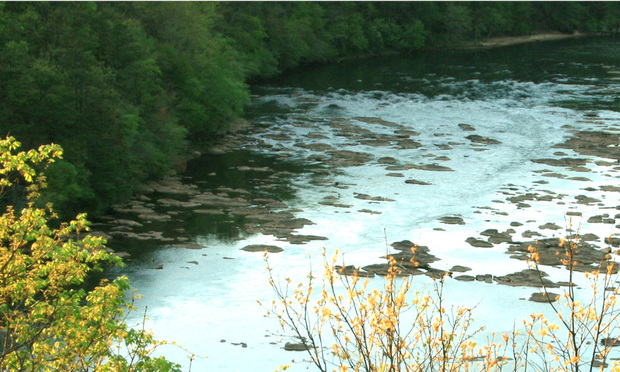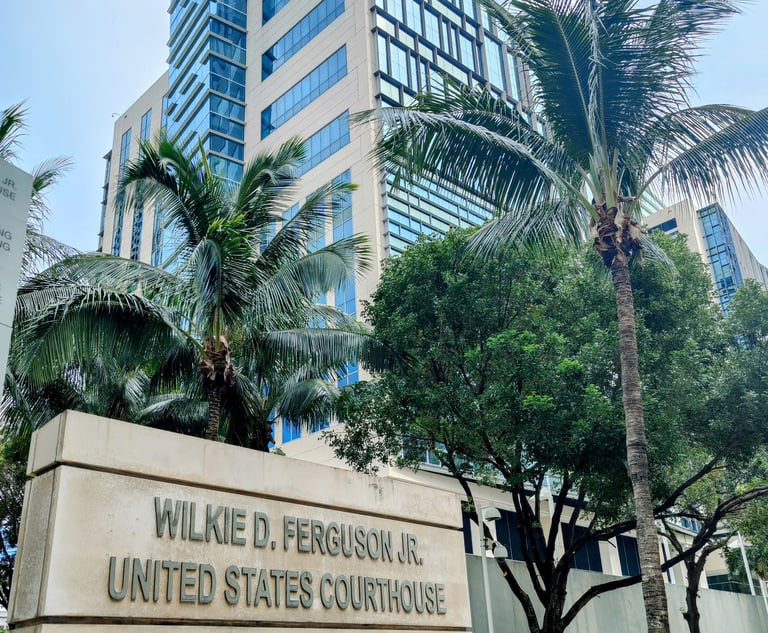Florida, Georgia Square Off Again in Long-Running Water War
A federal appellate judge based in New Mexico will have to sort out the battle between Florida and Georgia over water in the Apalachicola-Chattahoochee-Flint river system.
March 06, 2019 at 01:04 PM
4 minute read
 Apalachicola-Chattahoochee-Flint River Basin. Photo by USGS National Water Census.
Apalachicola-Chattahoochee-Flint River Basin. Photo by USGS National Water Census.
Florida says the case is the “last, best hope” to save the Apalachicola River region from destruction.
Georgia says Florida's arguments threaten to cause hundreds of millions of dollars in “real harm” to the Peach State.
Now, a federal appellate judge based in New Mexico will have to sort out the long-running battle between Florida and Georgia over water in the Apalachicola-Chattahoochee-Flint river system, which starts in Georgia and flows south into the Florida Panhandle.
Both sides filed briefs last week as they attempt to sway Senior U.S. Circuit Court of Appeals Judge Paul J. Kelly Jr. in the debate about whether limits should be placed on Georgia's water usage in the river system. Those briefs followed another set of briefs filed at the end of January.
Kelly was named as a special master in the case after a divided U.S. Supreme Court in June overturned a 2017 recommendation by another special master, Ralph Lancaster, who said Florida had not proved its case “by clear and convincing evidence” that imposing a cap on Georgia's water use would benefit the Apalachicola River region.
Writing for a 5-4 majority, Justice Stephen Breyer said Lancaster had “applied too strict a standard” in rejecting Florida's claim.
The Supreme Court decision, however, did not resolve the water war between the neighboring states, kicking it back for additional arguments. In the brief filed last week, Florida's attorneys said Kelly, who serves on the U.S. Court of Appeals for the 10th Circuit, should recommend that the Supreme Court issue a “decree equitably apportioning the waters” of the Apalachicola-Chattahoochee-Flint basin.
Florida contends, in part, that water usage by farmers in Southwest Georgia has reduced water flows in the river system, causing damage that includes major problems in the oyster industry in Apalachicola Bay.
“Ultimately, this is not a matter of simply dollar and cents, but of protecting and preserving irreplaceable natural resources,” Florida's brief said. “In their candid moments, Georgia's own officials have recognized all this. They understand the problem's source (agricultural withdrawals), its magnitude, and that it is solvable with exactly the type of common-sense steps Florida has suggested — with limited impact on Georgia's economy and farmers. Yet Georgia has failed to act because, as Special Master Lancaster recognized, it lacks the political incentive (or will) to do so. This action represents the last, best hope to change that, and save the Apalachicola region from destruction.”
But Georgia's attorneys, in a brief last week, accused Florida of “empty rhetoric” and said Florida had not proved that the benefits of a water limit would outweigh harm to Georgia.
“In remanding this case, the Supreme Court could not have been clearer that 'Florida will be entitled to a decree only if it is shown that 'the benefits of the [apportionment] substantially outweigh the harm that might result,' ” the Georgia attorneys wrote. “Not only has Florida failed to make that showing, but the record proves the opposite: the economic harms to Georgia from Florida's proposed cap would overwhelm any minimal and speculative benefits to Florida.”
From Florida's perspective, perhaps the highest-profile issue in the legal fight has been a decline in recent years of the oyster industry in Apalachicola Bay. Florida contends that a lack of freshwater flowing from the north has increased salinity in the bay and affected oyster production.
But Georgia is attacking that argument, contending that Florida allowed over-harvesting of oysters after the 2010 Deepwater Horizon oil spill in the Gulf of Mexico, causing lasting damage to the industry.
“Florida's case boils down to this: a largely self-inflicted injury to its $5-8-million-per-year oyster industry, which it now tries to leverage into a punitive and devastating cap that will cost Georgia hundreds of millions, if not billions, of dollars in real harm,” the Georgia brief said. “That is not the stuff of an equitable apportionment.”
Florida disputes such arguments and contends that increased salinity in the bay has led to more saltwater predators.
“The bay's oyster population can recover, but only if there is a surviving oyster population to facilitate reseeding from those areas,” Florida's brief last week said. “But if high salinities persist or recur, salt water predators will control the bay and recovery will not occur.”
Jim Saunders reports for the News Service of Florida.
This content has been archived. It is available through our partners, LexisNexis® and Bloomberg Law.
To view this content, please continue to their sites.
Not a Lexis Subscriber?
Subscribe Now
Not a Bloomberg Law Subscriber?
Subscribe Now
NOT FOR REPRINT
© 2025 ALM Global, LLC, All Rights Reserved. Request academic re-use from www.copyright.com. All other uses, submit a request to [email protected]. For more information visit Asset & Logo Licensing.
You Might Like
View All
'Close Our Borders?' Senate Judiciary Committee Examines Economics, Legal Predicate for Mass Deportation Proposal
3 minute read

'Stab Venequip in the Back': Caterpillar Faces $100M Lawsuit in Miami Federal Court
3 minute read
Another Roundup Trial Kicks Off in Missouri. Monsanto Faces 3 Plaintiffs
4 minute readTrending Stories
Who Got The Work
Michael G. Bongiorno, Andrew Scott Dulberg and Elizabeth E. Driscoll from Wilmer Cutler Pickering Hale and Dorr have stepped in to represent Symbotic Inc., an A.I.-enabled technology platform that focuses on increasing supply chain efficiency, and other defendants in a pending shareholder derivative lawsuit. The case, filed Oct. 2 in Massachusetts District Court by the Brown Law Firm on behalf of Stephen Austen, accuses certain officers and directors of misleading investors in regard to Symbotic's potential for margin growth by failing to disclose that the company was not equipped to timely deploy its systems or manage expenses through project delays. The case, assigned to U.S. District Judge Nathaniel M. Gorton, is 1:24-cv-12522, Austen v. Cohen et al.
Who Got The Work
Edmund Polubinski and Marie Killmond of Davis Polk & Wardwell have entered appearances for data platform software development company MongoDB and other defendants in a pending shareholder derivative lawsuit. The action, filed Oct. 7 in New York Southern District Court by the Brown Law Firm, accuses the company's directors and/or officers of falsely expressing confidence in the company’s restructuring of its sales incentive plan and downplaying the severity of decreases in its upfront commitments. The case is 1:24-cv-07594, Roy v. Ittycheria et al.
Who Got The Work
Amy O. Bruchs and Kurt F. Ellison of Michael Best & Friedrich have entered appearances for Epic Systems Corp. in a pending employment discrimination lawsuit. The suit was filed Sept. 7 in Wisconsin Western District Court by Levine Eisberner LLC and Siri & Glimstad on behalf of a project manager who claims that he was wrongfully terminated after applying for a religious exemption to the defendant's COVID-19 vaccine mandate. The case, assigned to U.S. Magistrate Judge Anita Marie Boor, is 3:24-cv-00630, Secker, Nathan v. Epic Systems Corporation.
Who Got The Work
David X. Sullivan, Thomas J. Finn and Gregory A. Hall from McCarter & English have entered appearances for Sunrun Installation Services in a pending civil rights lawsuit. The complaint was filed Sept. 4 in Connecticut District Court by attorney Robert M. Berke on behalf of former employee George Edward Steins, who was arrested and charged with employing an unregistered home improvement salesperson. The complaint alleges that had Sunrun informed the Connecticut Department of Consumer Protection that the plaintiff's employment had ended in 2017 and that he no longer held Sunrun's home improvement contractor license, he would not have been hit with charges, which were dismissed in May 2024. The case, assigned to U.S. District Judge Jeffrey A. Meyer, is 3:24-cv-01423, Steins v. Sunrun, Inc. et al.
Who Got The Work
Greenberg Traurig shareholder Joshua L. Raskin has entered an appearance for boohoo.com UK Ltd. in a pending patent infringement lawsuit. The suit, filed Sept. 3 in Texas Eastern District Court by Rozier Hardt McDonough on behalf of Alto Dynamics, asserts five patents related to an online shopping platform. The case, assigned to U.S. District Judge Rodney Gilstrap, is 2:24-cv-00719, Alto Dynamics, LLC v. boohoo.com UK Limited.
Featured Firms
Law Offices of Gary Martin Hays & Associates, P.C.
(470) 294-1674
Law Offices of Mark E. Salomone
(857) 444-6468
Smith & Hassler
(713) 739-1250






